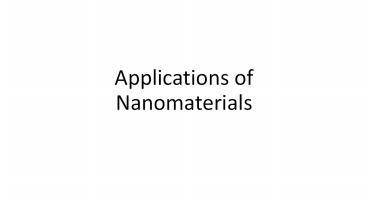Application of Nanomaterials PowerPoint PPT Presentation
Title: Application of Nanomaterials
1
Applications of Nanomaterials
2
Application of nanomaterials in the field of
catalysts
- Nanomaterials play an important role in many
chemical catalytic fields, which can control
reaction time and increase reaction efficiency
and speed. As catalysts, nanomaterials have many
advantages. Nanomaterials have large specific
surface area and many surface active centers, all
of which provide the necessary conditions for
catalysis. At the same time, the volume effect
and surface effect of nanomaterials determine its
good catalytic activity and catalytic
selectivity. Compared with the general catalyst,
nanocatalyst can greatly improve the reaction
efficiency, and it reacts 10 to 15 times faster
than the general catalyst. The metal
nanoparticles can be directly used as catalysts,
and the catalysts are mainly nano powders of
noble metals such as Ag, Pd, Pt, Rh, etc., and
base metals such as Fe, Co, Ni, and the like. The
use of metal microparticles as a catalyst has
good selectivity, and this selectivity is related
to the particle size of the nanoparticles. In
addition to chemical catalysis, photocatalysis
and thermal catalysis of semiconductor
nanoparticles have attracted widespread attention
and have been applied in catalytic degradation of
organic matter.
3
Application of nanomaterials in the preparation
of new engineering materials
- The small size effect of the nano material allows
it to be sintered at a lower temperature to
obtain a sintered body with excellent texture,
and can maintain its good performance without any
additives, so it can be used to prepare sintered
materials at low temperature. At the same time,
these nanomaterials can be used as activators in
the relevant sintering process, which plays an
important role in accelerating the sintering
process, shortening the sintering time and
lowering the sintering temperature. The small
size effect and surface effect of nanomaterials
not only reduce their melting point but also
reduce the phase transition temperature, so that
the melting point and phase transition
temperature of different materials can be closer
to each other and solid state reactions can be
performed at low temperatures. Different kinds of
nano-ceramic powders can be used to produce
nano-ceramics with dense texture and excellent
performance at low temperature and low pressure.
Nano-ceramics have excellent properties such as
good plasticity, high hardness, high temperature
resistance, wear resistance, high susceptibility
and coercivity, and low magnetic loss.
4
Application of nanomaterials in the field of
magnetic materials
- Magnetic materials are key materials for the
storage, processing and transmission of
information. In recent years, with the rapid
development of information, the performance of
recording medium materials, especially the
recording density, has been improved. The
recording medium material with high recording
density is closely related to ultrafine
particles. If ultrafine particles are used as the
recording unit, the recording density can be
greatly improved. Because the nano magnetic
particles have a single magnetic domain structure
and high coercive force, using it to make a
magnetic recording material can improve the
signal-to-noise ratio of the magnetic recording
material, thereby improving image quality.
5
Application of nanomaterials in the field of
coatings
- Due to its unique photocatalytic function,
nanomaterials have a strong decomposition and
elimination effect on toxic gases in the air. The
low surface tension, strong adhesion, and
excellent self-cleaning function make the
nano-materials suitable for exterior wall
coatings of buildings. Because the size of
nanometers is much smaller than the wavelengths
of infrared and radar waves, the transmission of
nanoparticles to these waves is much stronger
than that of conventional materials, and the
reflectance of infrared and radar waves is
greatly reduced. Therefore, nanomaterials have an
absorption effect on infrared and radar waves, so
they can be used as coating materials for
aircraft and submarines. Nano-coating will bring
a new technological revolution to the coating
technology, and will also promote the research
and development of composite materials.
6
Application of nanomaterials in the development
of new energy
- The rational use of traditional energy sources
and the development of new energy sources are
long-term and important tasks. In recent years,
research on the development of nano-purifiers and
nano-combustion aids that can be used for coal
and oil combustion, and the use of nanotechnology
to extract useful substances in coal ash have
obtained preliminary results and are expected to
be industrialized. Loading precious metals on the
surface of nano-semiconductor materials can
double the efficiency of photodecomposing water,
which will greatly promote the photochemical
storage of solar energy. The photoelectric
conversion efficiency of the new type solar cell
made of semiconductor nanomaterials is extremely
high, and it can work normally even in rainy days.
7
Conclusion
- In addition to the above applications,
nanomaterials have good application prospects in
the fields of printing inks, electronic pastes,
sensors, and artificial intelligence. For
example, the color of a nanoparticle varies
depending on the particle size, and the smaller
the particle size, the darker the color.
Therefore, non-toxic nanoparticles with
appropriate and uniform particle size can be used
to prepare printing inks of various colors to
replace traditional inks configured with chemical
pigments, and this is very beneficial for
improving the printing operation conditions,
preventing the ink from harming the human body
and protecting the environment.

